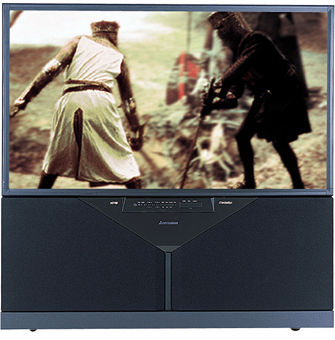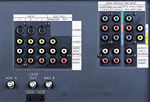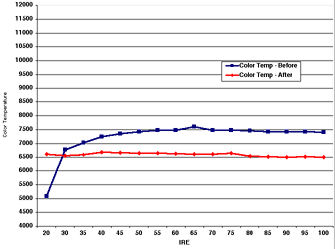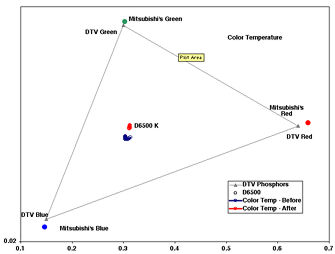The Monster TV Face Off Mitsubishi WS-55819
Last month, we reviewed Mitsubishi's WS-55859, which includes an HDTV tuner and IEEE 1394 inputs. The WS-55819 is a more-stripped-down version, lacking both the tuner and the 1394 inputs. However, Mitsubishi has publicly promised that, for less than $1,000, the company will upgrade any of its existing HD-capable displays with a module that will include a 1394 input. For those of you who haven't heard, IEEE 1394 is one of the two proposed methods for digitally transmitting HDTV signals from an outboard tuner (or any digital source, for that matter) to a TV. (See our sidebar on the topic.) This promise ensures that the WS-55819 will be compatible with future high-definition set-top boxes, which may be reason enough to consider purchasing it.

Another reason is the set's input panel. As shown in the feature-comparison chart, this set has enough inputs to handle any home theater system. You can tweak each input individually so that each source looks its best. The onscreen menu makes this extremely easy to do. Add Mitsubishi's standard remote, and the system's ergonomics are hard to beat. The remote fits comfortably in your hand and is well laid out, while the attractive onscreen graphics make finding functions relatively intuitive.
 For all of its ease of adjustment, this set doesn't have some of the picture controls that other sets did. Of course, all of the regular controls are there (contrast, brightness, color, tint, sharpness, and color temperature), but there was no way, for example, to change the color-decoder settings, even in the service menu. The factory setting tends to push red slightly, something both Adrienne and Mr. HD found objectionable. Lowering the color control helped alleviate this to a point that C Dogg found it pleasing and natural with DVD images. The black level also seems to change with the rest of the picture material. Big Papa noticed that the floating DC level makes brighter scenes lose some shadow detail.
For all of its ease of adjustment, this set doesn't have some of the picture controls that other sets did. Of course, all of the regular controls are there (contrast, brightness, color, tint, sharpness, and color temperature), but there was no way, for example, to change the color-decoder settings, even in the service menu. The factory setting tends to push red slightly, something both Adrienne and Mr. HD found objectionable. Lowering the color control helped alleviate this to a point that C Dogg found it pleasing and natural with DVD images. The black level also seems to change with the rest of the picture material. Big Papa noticed that the floating DC level makes brighter scenes lose some shadow detail.
 Otherwise, the set had one of the sharpest pictures in the group. The image appears more detailed, thanks to SVM, which you can't defeat from the user menu. Having a technician disable this function from the service menu improves true detail (and eliminates some ghosting), although it might seem to make the image slightly softer. The true detail level is even more evident with HD images, which are extremely well defined—so much so, in fact, that Maureen described them in a single word: "Breathtaking." Again, though, you need to lower the color level to compensate for the red-tinged color decoder.
Otherwise, the set had one of the sharpest pictures in the group. The image appears more detailed, thanks to SVM, which you can't defeat from the user menu. Having a technician disable this function from the service menu improves true detail (and eliminates some ghosting), although it might seem to make the image slightly softer. The true detail level is even more evident with HD images, which are extremely well defined—so much so, in fact, that Maureen described them in a single word: "Breathtaking." Again, though, you need to lower the color level to compensate for the red-tinged color decoder.
You can correct the color temperature, with fantastic results (see measurements), and you'll find that the internal line doubler does an OK job with film sources, even though nearly all of the sets failed the Video Essentials 3:2 zone-plate test. Although it took a second to find its groove, the Mitsubishi set kept the diagonal lines of the Phantom Menace (chapter 10) tanks and turret guns straight, while some other sets turned them into the jagged sides of a Mayan pyramid.
The set's color decoder and factory color-balance setting probably kept the display from taking higher honors. I've often found that Mitsubishi's TVs provide a solid chassis from which to work. Unfortunately, they're tweaked at the factory to look good to the average person on a retail sales floor. Once you get them home, they need trained effort (and test equipment) to look as good as they are capable of. Given Mitsubishi's commitment to future compatibility, I've almost exclusively recommended their sets to friends, under the caveat that they have the set calibrated. You might do the same.—MW
WS-55819 HD Monitor $3,800
Mitsubishi Digital Electronics
(800) 332-2119
www.mitsubishi-tv.com
Dealer Locator Code MSU

HT Labs Measures:Mitsubishi HD Monitor


The top chart shows the gray scale of the Mitsubishi HD monitor as set by the manufacturer, in the most accurate menu setting possible. The set measures around 7,500 Kelvin with most images. After making adjustments using the Photo Research PR-650, the gray scale measures within 150 K of D6500, the accurate setting, across the entire range. The bottom chart shows that the primary colors of the display's CRTs are excellent, matching those specified by SMPTE. This means that the display will reproduce all of the colors available in the system. The gray scale, shown in the middle of the triangle, goes from being slightly blue before calibration to being extremely accurate (the middle red dots) afterward. The light output was approximately 30 foot-lamberts. The display has OK DC restoration: Dark portions of the image get slightly darker as the image gets brighter. Only a technician, through the service mode, can disable scan velocity modulation. The color decoder pushes red as set by the factory, although the comb filter does a good job of eliminating dot crawl. The TV displays at least 550 horizontal lines (per picture height) with NTSC sources, as measured using the resolution pattern from the Ovation Avia test DVD played on a Sony CDP-650D DVD player.—MW/GM





























































